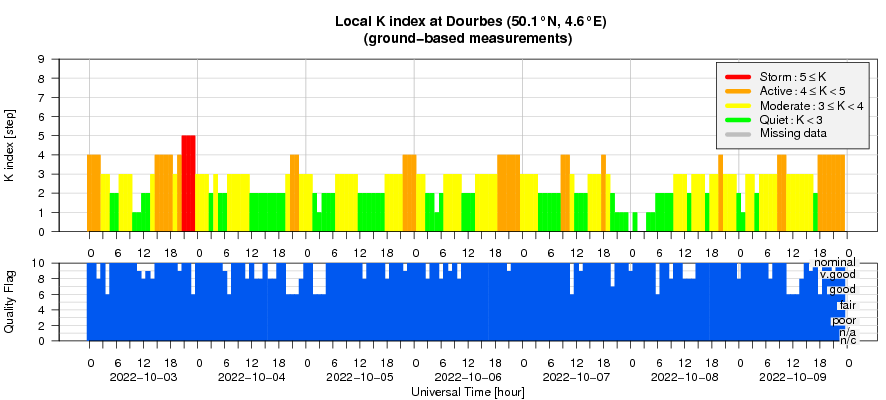- Table of Content
- 1.And so they me...
- 2.Latest news on...
- 3.Review of sola...
- 4.Review of geom...
- 5.The SIDC Space...
- 6.PROBA2 Observa...
- 7.The Internatio...
- 8.Noticeable Sol...
- 9.Geomagnetic Ob...
- 10.Action!
2. Latest news on SC25
3. Review of solar activity
4. Review of geomagnetic activity
5. The SIDC Space Weather Briefing
6. PROBA2 Observations (3 Oct 2022 - 9 Oct 2022)
7. The International Sunspot Number by SILSO
8. Noticeable Solar Events (3 Oct 2022 - 9 Oct 2022)
9. Geomagnetic Observations at Dourbes (3 Oct 2022 - 9 Oct 2022)
10. Action!
And so they meet again…
Solar Orbiter speeds towards its next rendezvous with the Sun
The Solar Orbiter mission makes a new close approach to the Sun on 12 October at 19:12 UTC. This time the satellite will be as close as 0.29 AU or 43 million km to the Sun, even closer than at the previous perihelion in March 2022 (0.32 AU). All instruments onboard are ready to collect yet more ground-braking data during this unique observation period.
Throughout the course of its mission, Solar Orbiter will have 2 close approaches each year and due to the increasingly inclined orbit that the satellite will follow, these will also allow us to observe the solar poles close-by for the very first time. Something exiting to look forward to!
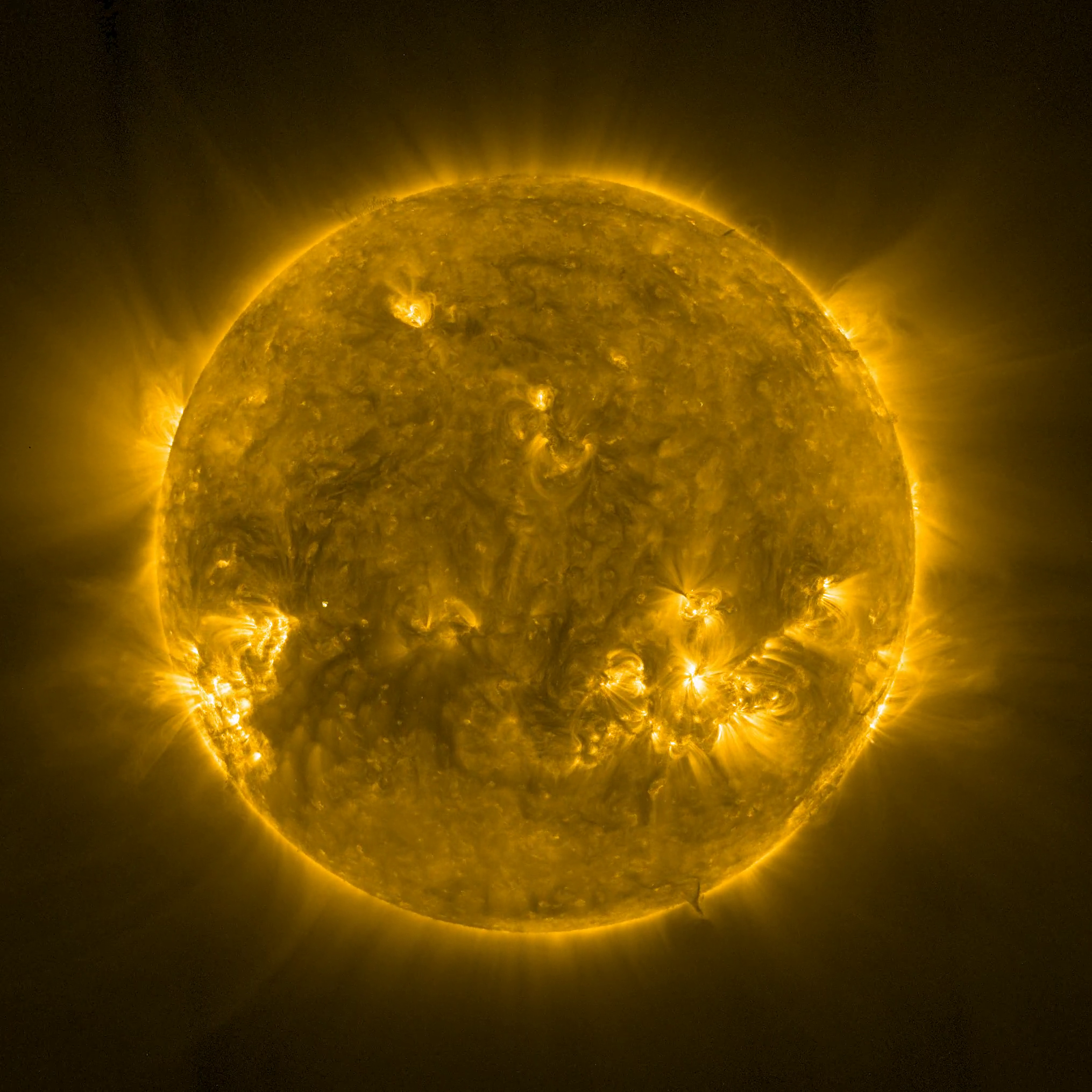
Follow this link to see a movie showing the progress of the spacecraft as it heads towards our star, with the Sun seemingly growing in size as the spacecraft approaches: https://www.sidc.be/users/emilk/202210_EUI_perihelium/approach_FSI174_clean.mp4
The sequence begins on 20 September and finishes on 10 October and was taken by the Extreme Ultraviolet Imager (EUI) using the Full Sun Imager (FSI) telescope.
Towards the end of the sequence, the image appears to jump slightly. This happens on the days that EUI was not returning data to Earth.
More info can be found on ESA's webpage: https://www.esa.int/ESA_Multimedia/Videos/2022/10/Solar_Orbiter_speeds_towards_its_next_rendezvous_with_the_Sun
Latest news on SC25
The STCE's SC25 Tracking page (https://www.stce.be/content/sc25-tracking ) has been updated to reflect the latest evolution in some critical space weather parameters for the ongoing solar cycle 25 (SC25), from sunspot number all the way to cosmic rays. The multiple graphs allow for a comparison with previous solar cycles at similar stages in their evolution. Over the last few months, the monthly sunspot number (SILSO - https://www.sidc.be/silso/ ) has stabilized around 85. The current smoothed monthly sunspot number is still about 35% higher than what was predicted (68.9 observed vs. 50.6 predicted). IF this trend continues, then SC25 maximum will be higher than expected.
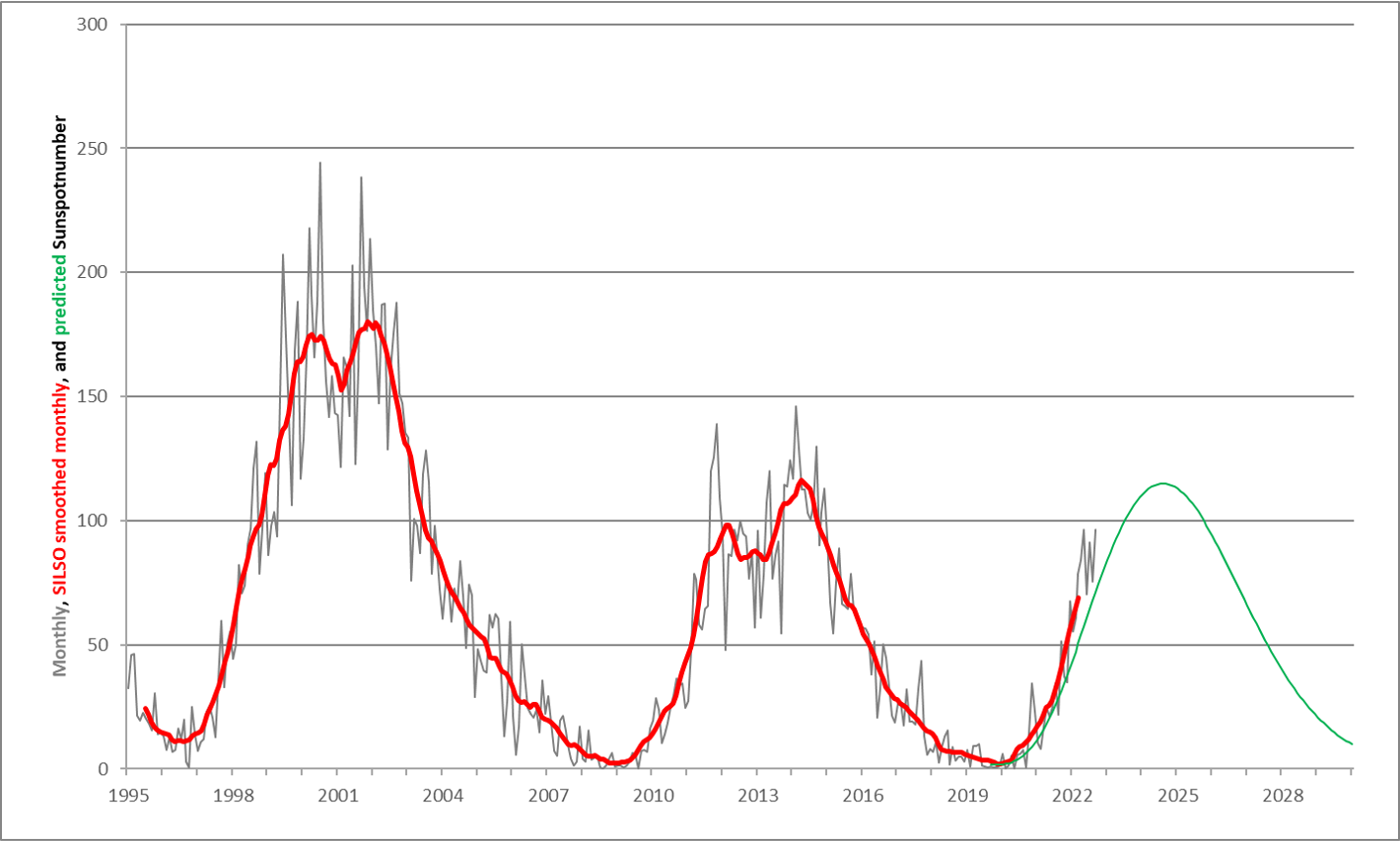
During the period June-September 2022, most of the flaring activity was generated by sunspot groups on the southern hemisphere. An example of elevated flaring activity can be found in the extreme ultraviolet imagery underneath (SDO/AIA 131 - https://sdo.gsfc.nasa.gov/data/aiahmi/ ), when on 28 and 29 August, active region NOAA 13088 was the source of some important flaring events such as an M6 and an M8 flare while rounding the southwest solar limb.
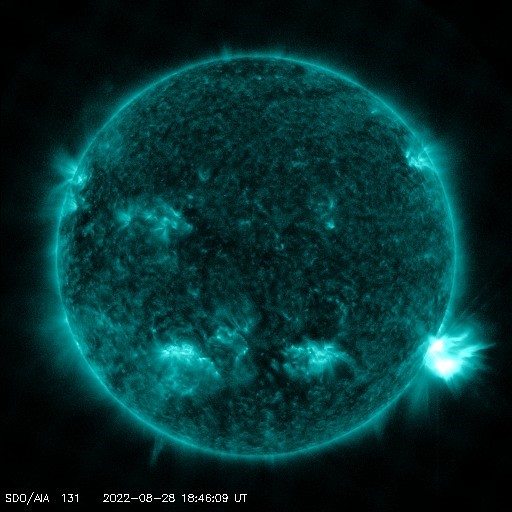
The effect of the enhanced solar activity of this year is also reflected in the decreasing trend of neutron counts. When galactic cosmic rays (GCR) or high-energetic (> 500 MeV) solar protons interact with particles in the Earth's upper atmosphere, the created secondary particles can reach all the way down to the Earth's surface where they can be measured by e.g. neutron monitors such as in Dourbes, Belgium (http://dourbes.meteo.be/en/products-services/services/cosmicray ). The evolution of the neutron counts anti-correlates with the solar cycle activity because during periods of increased solar activity, the turbulent solar wind and the continued series of coronal mass ejections provide sort of a magnetic shield against the GCR, and neutron counts are low. During solar cycle minimum, this magnetic barrier is much less prominent allowing the GCR an easier access to the earth environment and thus resulting in elevated neutron counts. The graph below shows the evolution of the (unsmoothed) monthly neutron count (counts/minute ; corrected for air pressure and efficiency) as monitored by the Cosmic Rays station of the University of Oulu, Finland (http://cosmicrays.oulu.fi/ ). This station has one of the longest running databases for this parameter, starting in 1964. Current evolution of the neutron counts (decreasing) shows the effect of the increased solar activity of the last few months, thus keeping more of the cosmic rays away from the Earth.
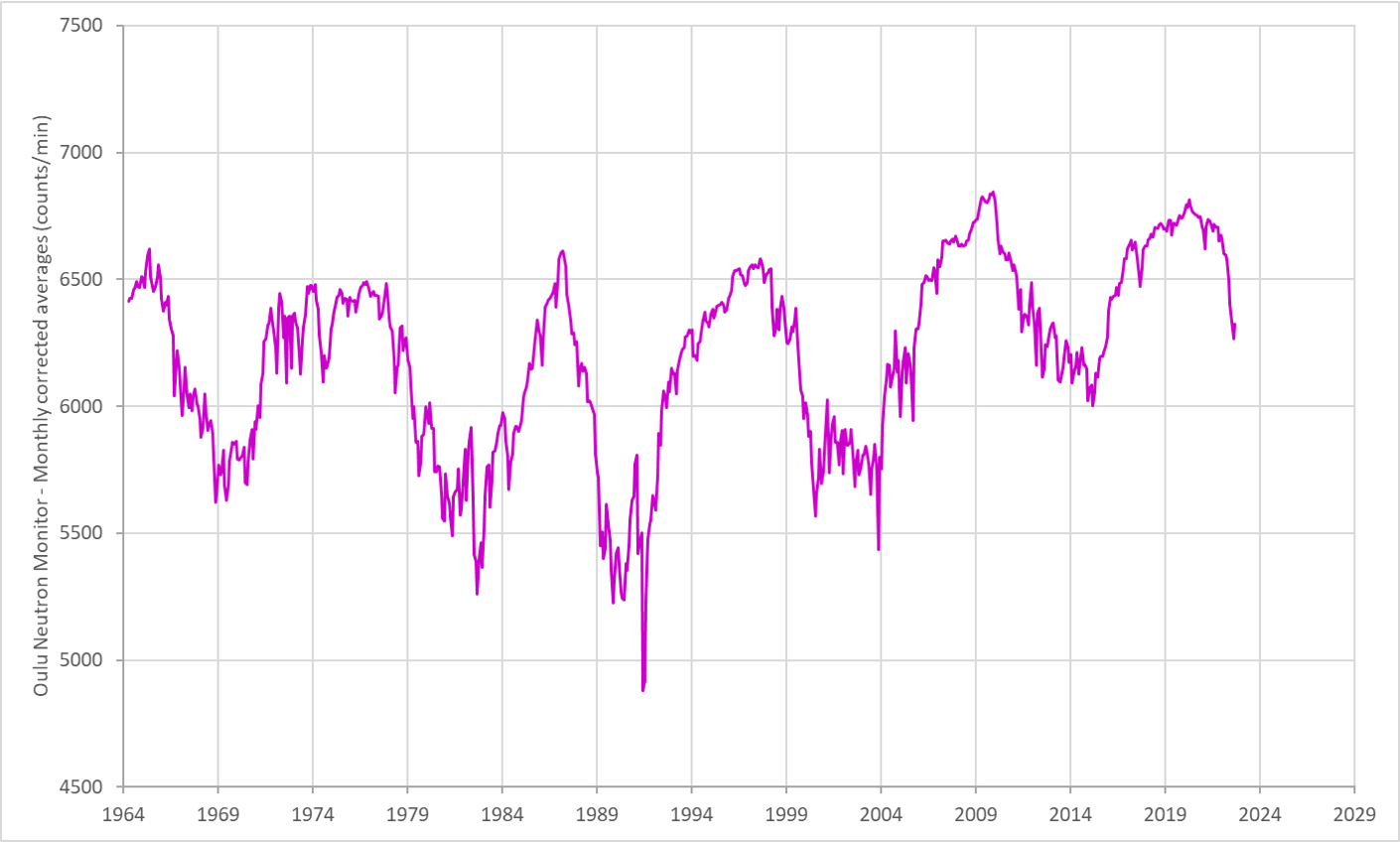
Review of solar activity
Solar flares
The past week started with high solar flaring activity.
Catania sunspot group 48 (NOAA AR 3110, beta magnetic complexity) on the north-west quadrant of the Sun produced M-class flares followed by an X1.0-flare peaking at 20:25 UTC on October 2, which was associated with a Type II radio burst.
The very complex Catania sunspot group 55 (NOAA AR 3112, beta-gamma-delta magnetic complexity) was observed and carefully monitored through the whole week, but it only produced few M-class flares. Later during the week, the solar flaring activity became moderate to quiet with a few isolated M-class flares from Catania sunspot group 48, 55 and 56 (NOAA AR 3116).
Coronal Mass Ejections
A large coronal dimming associated with the X1.0-flare was observed on October 2. The following coronal mass ejection had no Earth directed component due to the non-geoeffective location of the source region on the sun. On October 5, a filament near the central meridian erupted. The CME travelled in the south direction and its plane-of-sky speed was around 570 km/s. No impact near Earth was seen.
On October 07, a coronal mass ejection (CMEs) in the North-West direction was detected. A filament in the North-West quadrant of the Sun erupted at 07:00 UTC that day. The CME had a plane-of-sky speed around 280 km/s. No Earth impact was expected from this slow coronal mass ejection.
Solar energetic particles
After the X1.0-class flare October 2 peaking at 20:25 UTC, the greater than 10 MeV proton flux showed a small increased just above the background level, but remained fully below the minor storm warning threshold. The greater than 10 MeV proton flux remained at nominal levels for the rest of the week.
The greater than 2 MeV electron flux was below the 1000 pfu threshold in the beginning of the week. Starting from October 05, it crossed the 1000 pfu threshold and remained above for the rest of the week. The 24h electron fluence was at moderate to high levels starting on October 06 and for the rest of the week.
Review of geomagnetic activity
Solar wind parameters were slightly elevated due to a high-speed solar wind emanating from coronal holes. The solar wind speed was between 430 km/s and 600 km/s. The interplanetary magnetic field ranged between 2 nT and 16 nT. The southward component of the interplanetary magnetic field fluctuated between -13 nT and 13 nT being mainly negative. The magnetic field was mostly directed away from the Sun.
Geomagnetic conditions were unsettled to active (NOAA Kp 2-4, local K-Dourbes 1-4) with short periods of minor storm recorded on October 02 and 03 due to the prolonged periods of a negative Bz component of the interplanetary magnetic field.
The SIDC Space Weather Briefing
The Space Weather Briefing presented by the forecaster on duty from Oct 2 to 9. It reflects in images and graphs what is written in the Solar and Geomagnetic Activity report: https://www.stce.be/briefings/20221010_SWbriefing.pdf
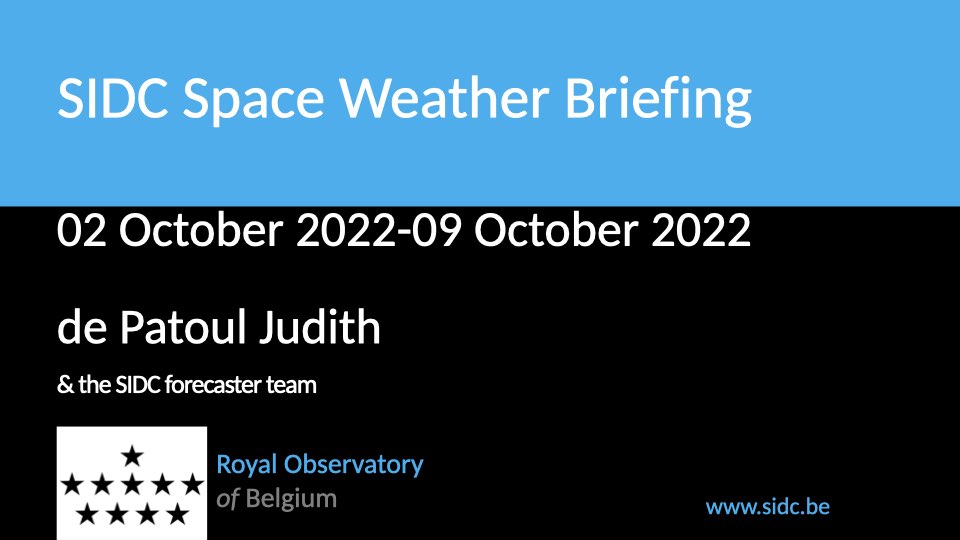
If you need to access the movies, contact us: stce_coordination at stce.be
PROBA2 Observations (3 Oct 2022 - 9 Oct 2022)
Solar Activity
Solar flare activity fluctuated from low to moderate during the week.
In order to view the activity of this week in more detail, we suggest to go to the following website from which all the daily (normal and difference) movies can be accessed: https://proba2.oma.be/ssa
This page also lists the recorded flaring events.
A weekly overview movie (SWAP week 654) can be found here: https://proba2.sidc.be/swap/data/mpg/movies/weekly_movies/weekly_movie_2022_10_03.mp4.
Details about some of this week's events can be found further below.
If any of the linked movies are unavailable they can be found in the P2SC movie repository here: https://proba2.oma.be/swap/data/mpg/movies/.
Monday October 03
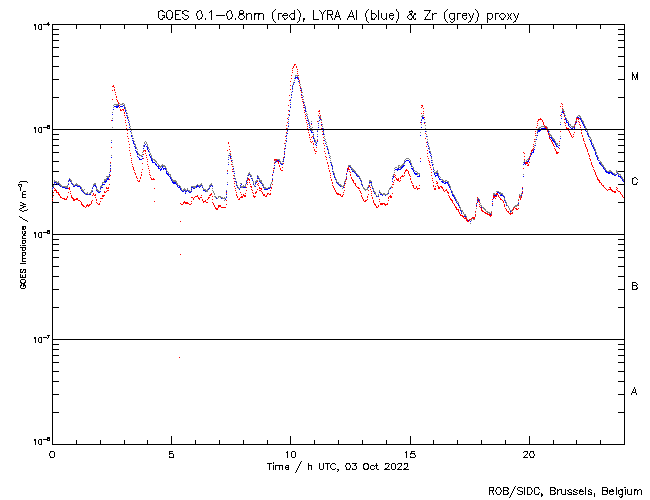
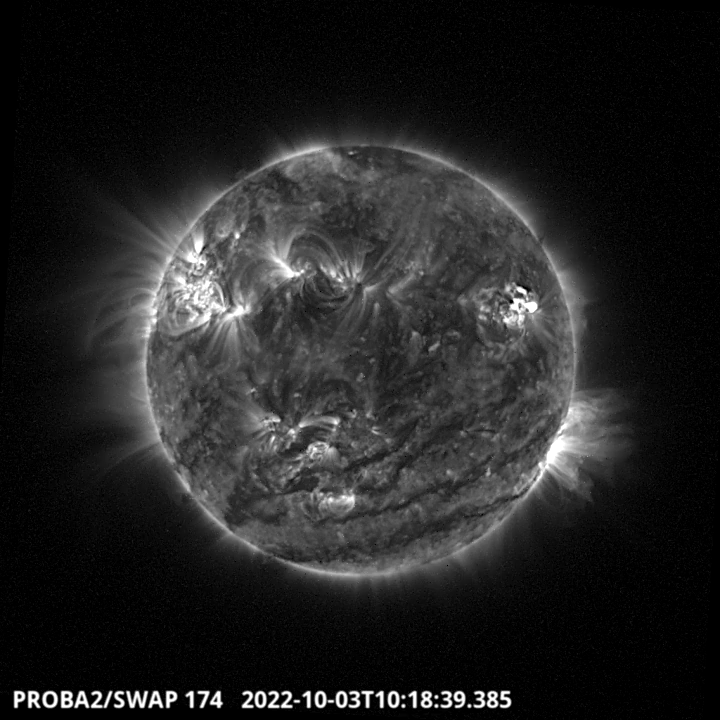
The largest flare of the week, an M4.2 flare, was observed by LYRA (top panel) and SWAP (bottom panel). The flare occurred on 2022-Oct-03 (peak at 10:11 UT) in the north-western hemisphere, and it was associated with NOAA AR3110.
Find a SWAP movie of the event here: https://proba2.sidc.be/swap/movies/20221003_swap_movie.mp4.
The International Sunspot Number by SILSO
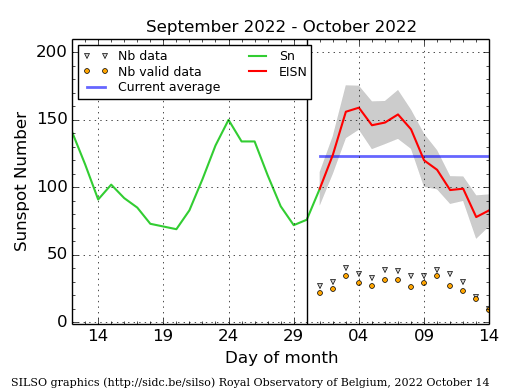
The daily Estimated International Sunspot Number (EISN, red curve with shaded error) derived by a simplified method from real-time data from the worldwide SILSO network. It extends the official Sunspot Number from the full processing of the preceding month (green line), a few days more than one solar rotation. The horizontal blue line shows the current monthly average. The yellow dots give the number of stations that provided valid data. Valid data are used to calculate the EISN. The triangle gives the number of stations providing data.
Noticeable Solar Events (3 Oct 2022 - 9 Oct 2022)
| DAY | BEGIN | MAX | END | LOC | XRAY | OP | 10CM | TYPE | Cat | NOAA |
| 03 | 0219 | 0233 | 0302 | N23E64 | M2.6 | SF | 170 | 55 | 3112 | |
| 03 | 0938 | 1011 | 1027 | M4.2 | III/2 | 48 | 3110 | |||
| 03 | 1103 | 1111 | 1119 | M1.5 | 48 | 3110 | ||||
| 03 | 1520 | 1530 | 1540 | N24E54 | M1.6 | 1N | 55 | 3112 | ||
| 03 | 1957 | 2028 | 2052 | M1.2 | 120 | |||||
| 03 | 2111 | 2122 | 2131 | M1.7 | ||||||
| 04 | 1248 | 1315 | 1351 | N17W66 | M1.6 | SN | IV/2VI/2 | 48 | 3110 | |
| 07 | 1421 | 1444 | 1532 | N29E10 | M1.0 | 1F | 56 | 3116 |
| LOC: approximate heliographic location | TYPE: radio burst type |
| XRAY: X-ray flare class | Cat: Catania sunspot group number |
| OP: optical flare class | NOAA: NOAA active region number |
| 10CM: peak 10 cm radio flux |
Action!
Check out our activity calendar: activities and encounters with the Sun-Space-Earth system and Space Weather as the main theme. We provide occasions to get submerged in our world through educational, informative and instructive activities.
If you want your event in our calendar, contact us: stce_coordination at stce.be
* October 19, seminar: Detecting Europa’s Water Plumes, onsite and online, Royal Observatory of Belgium
* October 20, seminar: The effect of flux rope heating models on solar prominence formation, onsite and online, CmPA, Leuven, Belgium
* October 20, Job vacancy EUI onboard Solar Orbiter - last day for submission
* October 24-28, 18th European Space Weather Week, Zagreb, Croatia
* November 21-23, Space Weather Introductory Course - onsite, by the STCE, Brussels, Belgium - fully booked
* November 22, seminar: Ionospheric Disturbances Detection by HF Doppler sounding, onsite and online, STCE
* November 27, Dag van de Wetenschap, Planetarium, Belgium
* December 5, 6, 8, 9, Space Weather Introductory Course - online, by the STCE, zoom - fully booked
Check: https://www.stce.be/calendar

